Posted by: Ken @ 4:06 pm
For Mary Lou, birding is not a sedentary pursuit. If she were a fisher-person, she would wait maybe 15 seconds for a nibble and, if none, would move on to the next fishing hole. If she were a fisher-bird, Mary Lou would be a Reddish Egret or a Tricolored Heron that seeks out prey by dashing and rushing about. I would be the Green Heron or the Great Blue, still as a statue, patiently waiting for the slightest ripple to materialize into a trophy.
I know she has my best interest at heart when she insists that all our bird walks must start out at full speed for at least the first mile. If we are out before sunrise, I don’t mind this very much. It’s too dark for photography, and I can bird by ear or test my peripheral vision as we speed by those little shadowy things fluttering in the roadside shrubs. Besides, a brisk aerobic walk is good for one’s body and spirits.
About a quarter of a mile along the unpaved road that runs into the wetland near our home, a path leads to a levee along the canal that forms the western border of our subdivision. Early in the morning, as we reported last week, Bobcats sometimes walk this path and chase after Marsh Rabbits and stalk for birds such as Common Ground Doves. (See Birds and a trio of Bobcats)
The two-track path atop the levee had not been maintained for several years, and became overgrown with tall grass and shrubs. This sharply limited the sight distance and interfered with my attempts to photograph the Bobcats. This past month a crew from the Water Management District came through and cut a 15-20 foot swath along the top of the levee. Now we can look south almost a mile to the Miami-Dade County line. We both enjoy seeing the Bobcats, so Mary Lou allows one brief detour along the path to a spot where we can check for wildlife.
A few mornings before we saw the mother Bobcat and two cubs, we checked the levee as usual, and found nothing of interest, then continued walking briskly the rest of the mile to the end of the road. By then the sky had brightened up, and on the way back I resumed my usual habit of scrutinizing the lake and surrounding wetlands. There was little of interest. Water levels are at their highest this time of year. Herons, ibises and storks are widely dispersed, not as in the late winter dry season, when fish and other aquatic creatures as well as the long-legged waders are concentrated in residual pools.
Impatient with my dawdling, Mary Lou decided to forge on ahead. I caught up with her while she was checking out the “fake hammock” (See Birding in a make-believe hammock), but it yielded no warblers– only catbirds, mockingbirds, cardinals and Blue Jays. I suggested that we check for Bobcats again, but she said she’d rather just walk back home. When I got to the top of the levee and looked down the path, I was surprised to see a Bobcat. It was dragging along a very large prey item that looked to be almost half its size. It turned and started walking away as I lifted my camera. Unfortunately, my handheld photos, taken at 300 yards, shed little light on the identity of the prey.
Click on the photo for more views. I suspect that the prey may have been a black house cat.
Cautiously moving out of the Bobcat’s view, I called Mary Lou to tell her about my find, but by then she had almost reached home. She doubted that the Bobcat would stay in place for her anyway, and was not about to walk back. Sure enough, it disappeared into the brush just after I looked back up the trail. Anticipating the possibility of obtaining another photo, I hurried up to where I last saw it.
After several minutes of quiet searching, I tried to attract the Bobcat by sucking on my knuckles to imitate the call of an injured rabbit . Actually, “knuckles” is an imprecise term– according to Webster’s New World Medical Dictionary, “Knuckle” means “the dorsal aspect of the flexed metacarpophalangeal (MCP) joint. Knuckle may be shorter and simpler to say.” I actually sucked on the next set of joints, a third of the way to my fingertips– the proximal interphalangeal (PIP) joints of the index and middle finger– they work much better.
It was like turning on a switch. The instant my squeak pierced the morning air, a House Wren burst into a loud chatter.
Almost immediately, a Blue Jay chimed in…
…followed by several mockingbirds…
…a cautious male Northern Cardinal…
…and his beautiful mate.
The alarm spread like electricity along the levee. Catbirds mewed…
…a Common Grackle chacked and crackled…
…and a Brown Thrasher let its presence known be with churrs and smacks.
An Eastern Towhee with red eyes flew up to see what was happening. Since our local towhees have yellow eyes, I knew it was a migrant from up north.
Even an Eastern Phoebe appeared out of nowhere.
By now it seemed that the birds had forgotten what had started this whole disturbance, and were feeding on each others’ excitement. Then, almost abruptly, it got quiet.
I saw why, as a Merlin sped by overhead (at least I think it was a Merlin– it happened so fast that I could only get a feeble parting shot).
On the way back home, I saw this beautiful female Painted Bunting, green on green in a treetop:
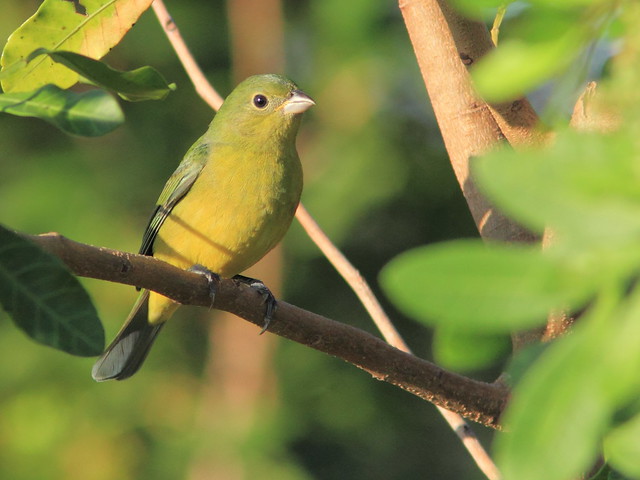













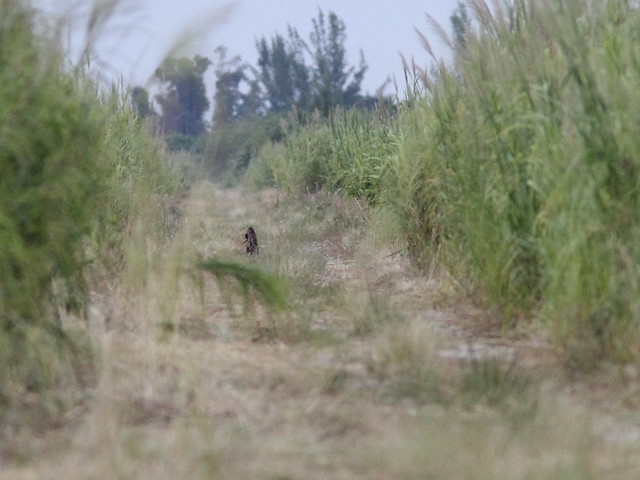
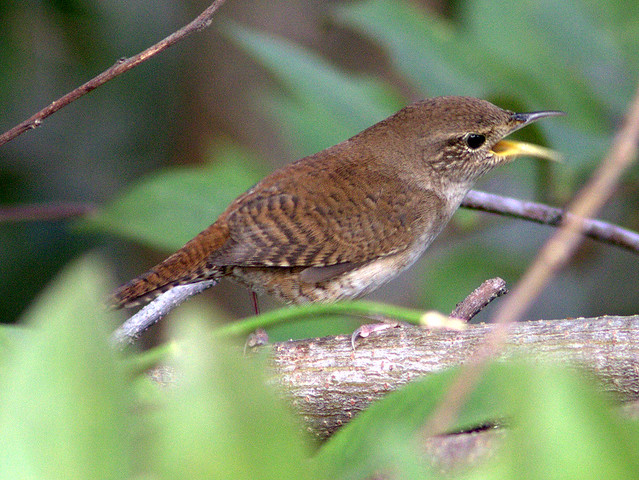
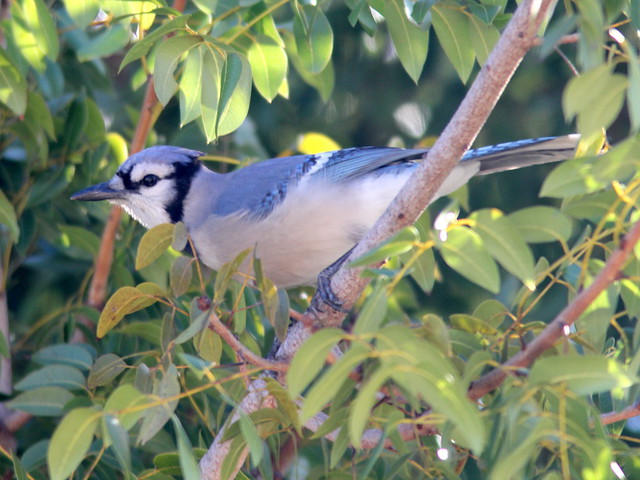
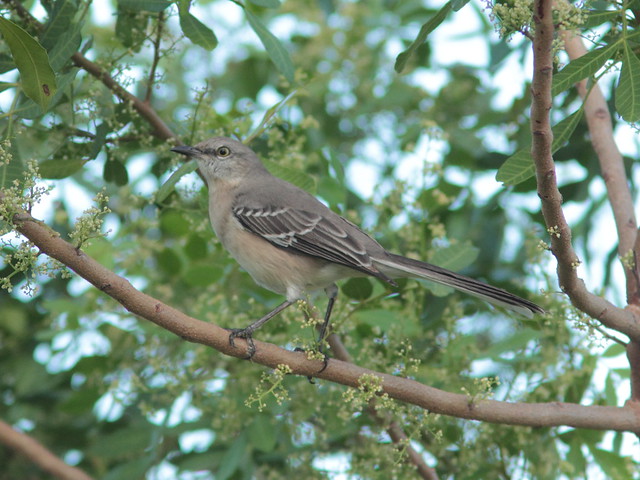
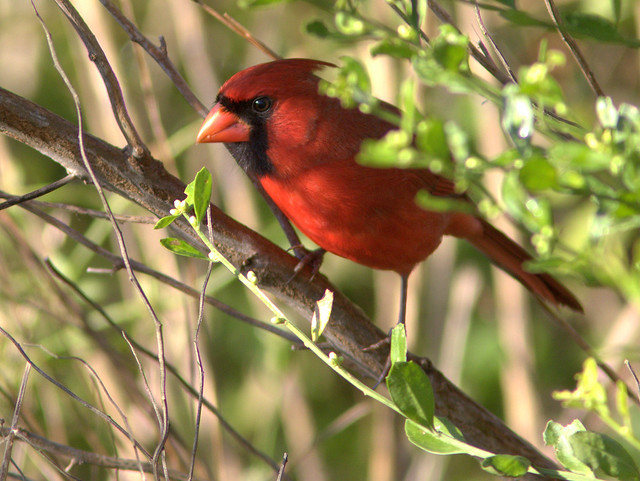
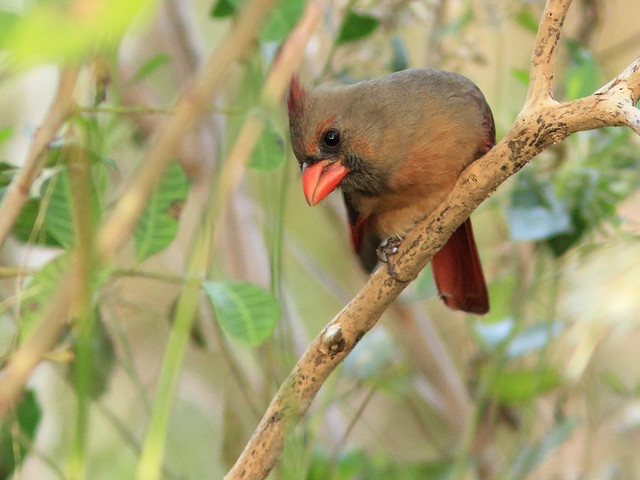
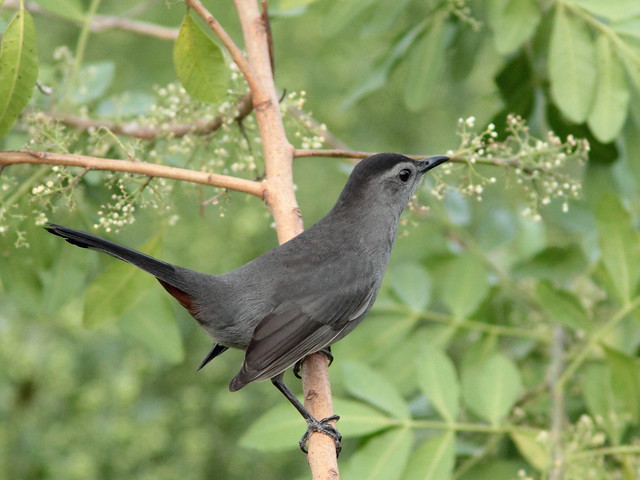
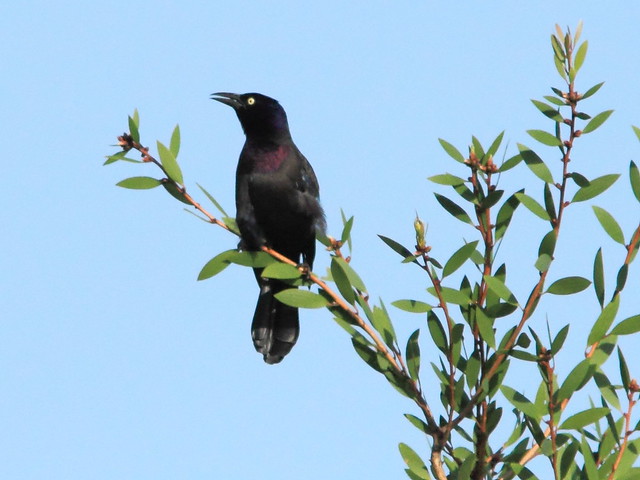
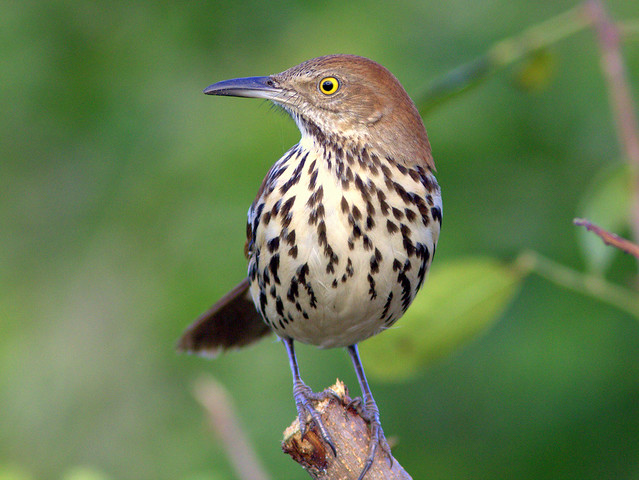
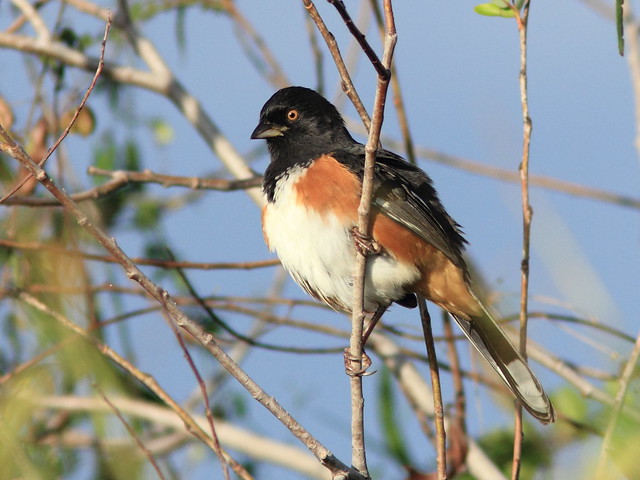
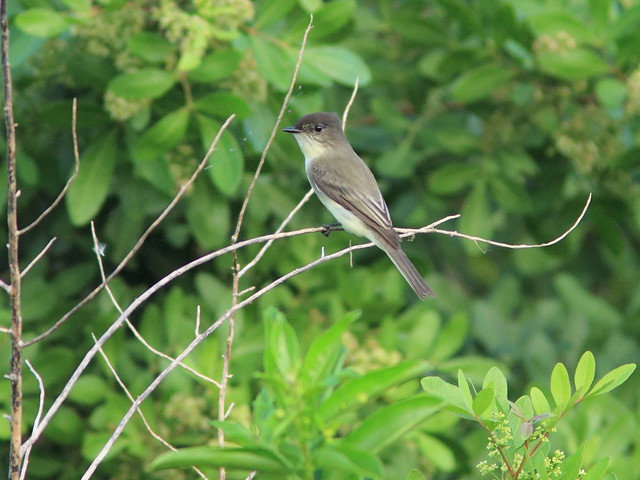
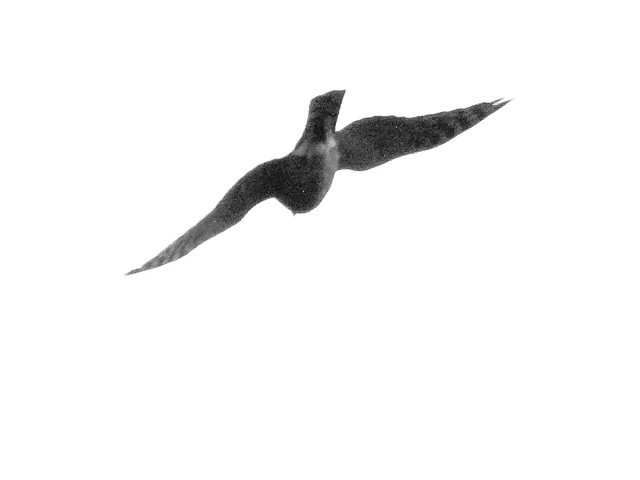
November 15th, 2011 at 5:05 pm Wonderful images of your lovely birds… Thanks for sharing.
November 15th, 2011 at 5:32 pm gorgeous cardinal and catbird shots! lovely!
November 15th, 2011 at 5:34 pm Fantastic series!! Boom & Gary of the Vermilon River, Canada.
November 15th, 2011 at 5:58 pm Hey, Ken, those are fantastic close-up’s! Very detailed and clear! Excellent work!
November 15th, 2011 at 6:39 pm I like your description of your walk and the different ways you both have of enjoying a walk! A very nice variety of birds responded to your call/noise? Great photos of course.
November 15th, 2011 at 7:25 pm Wow, what an awesome story. A bobcat sighting is cool. And I love your bird photos. Great post.
November 15th, 2011 at 9:40 pm Lovely images from your walk, especially liked the brown thrasher and eastern towhee.
November 16th, 2011 at 12:28 am What a great selection Ken; and all from a ’squeak’. The Eastern Towhee and Brown Thrasher, are beauties.
November 16th, 2011 at 6:02 am Oh I wait for the day of my first Bobcat sighting. Meanwhile seeing a series of birds as you did would be just fine. Great story.
November 16th, 2011 at 7:17 am And all that by just sucking on your not-knuckles! I must say, that was quite a trick! Great captures.
November 16th, 2011 at 7:53 am Great photos! Cannot chose a favourite.
November 16th, 2011 at 1:27 pm Some superb photograhy here. The Cardinal images have that specal appeal, the bird species helps of course…. the painted Bunting is so well composed and what a lovely bird.. The Brown Thrasher is overall brilliant Very very nice indeed
November 16th, 2011 at 3:11 pm Wow…what great photos.. every once in a while someone comes looking for a lost house cat and I tell them…coyotes…and they don’t think about it….Michelle
November 16th, 2011 at 5:59 pm Is it possible your photographs are getting even better? These are beautiful takes. It funny what catches one’s attention. For me the color in the cardinals eye just knocked me dead. Then it was one superb photograph after another. You prove my conjecture that bird photography is essentially a lone pursuit. The poor person that walks with a photographer has their walk interrupted by starts and stops they really don’t appreciate. “Why do you have to take a hundred shot of the same bird?” Is a hard question to answer. I hope your Lady likes looking at your pictures at least as much as I do! I got a good laugh from your story,for Suzanne and I it has a familiar ring! Bravo!
November 16th, 2011 at 7:42 pm I had a wonderful time here visiting,love the way you write ,your close encounters are amazing,your photos are beautiful,thanks for sharing your site,phyllis
November 17th, 2011 at 12:20 pm What a great read and your photos are fantastic! I’m envious of your Brown Thrasher shot!
November 19th, 2011 at 12:21 am it’s simply amazing the amount of different birds you got to see and photograph this morning; such beautiful birds; lovely photographs